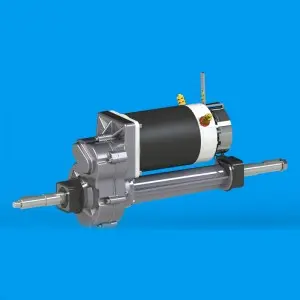The transaxle is a critical component in a vehicle’s drivetrain, responsible for transmitting power from the engine to the wheels. They play an important role in determining vehicle performance, and many enthusiasts are always looking for ways to increase transaxle speed. Whether you’re a racing enthusiast or just want to improve your vehicle’s performance, there are a number of strategies to consider when it comes to increasing the speed and overall efficiency of your transaxle.
Before delving into ways to make a transaxle faster, it’s important to understand the basic principles behind its operation. A transaxle combines the functions of the transmission, axle and differential into one integrated unit. This design is common in front-wheel drive and some rear-wheel drive vehicles. The transaxle not only transfers power from the engine to the wheels, but also plays a vital role in gear shifting and torque distribution.
One of the most effective ways to increase transaxle speed is to optimize its gear ratio. The gear ratio in the transaxle determines how fast the wheels rotate relative to engine speed. By adjusting the gear ratio, it is possible to achieve higher top speeds and improve acceleration. This can be accomplished by installing an aftermarket gear set specifically designed to improve performance. These gear sets are engineered to provide more aggressive gear ratios, resulting in faster acceleration and a higher top speed.
Another way to make a transaxle faster is to upgrade the clutch system. The clutch is responsible for engaging and disengaging the transmission from the engine, allowing for smooth shifting. Upgrading to a high-performance clutch improves the transaxle’s ability to handle more power and torque, resulting in faster acceleration and improved overall performance. Additionally, a lightweight flywheel can be installed to reduce rotating mass, further improving the transaxle’s responsiveness and speed.
Additionally, optimizing the transaxle’s cooling system can significantly improve its performance. High-performance driving and racing can generate excessive heat within the transaxle, resulting in reduced efficiency and potential damage. Upgrading the transaxle’s cooling system with a larger capacity radiator, improved airflow and high-quality coolant helps maintain optimal operating temperatures, ensuring consistent performance and reliability.
In addition to mechanical upgrades, tweaking the transaxle’s electronic control unit (ECU) can significantly improve speed and responsiveness. The ECU controls all aspects of transaxle operation, including shift points, torque distribution and throttle response. By reprogramming the ECU or installing a performance-oriented aftermarket unit, the behavior of the transaxle can be fine-tuned to maximize speed and acceleration.
Additionally, reducing the overall weight of the transaxle and driveline components can have a significant impact on their speed and performance. Lightweight materials such as carbon fiber, aluminum and titanium can be used to replace stock parts, reducing rotating mass and making the transaxle more efficient. Additionally, upgrading to high-performance axles and driveshafts can minimize power losses and improve torque transfer to the wheels, resulting in faster acceleration and higher speeds.
It is important to note that when increasing transaxle speeds, one must ensure that the vehicle’s overall drivetrain and suspension systems are properly matched to handle the increased performance. Upgrading the transaxle without addressing other critical components can lead to potential problems such as excessive wheel slip, loss of traction, and increased driveline stress.
In summary, increasing transaxle speed involves a combination of mechanical, electronic and weight reduction strategies. By optimizing gear ratios, upgrading the clutch system, improving cooling, tuning the ECU and reducing weight, the speed and overall performance of the transaxle can be significantly improved. However, it is crucial to carefully consider making these modifications and ensure that the vehicle’s entire drivetrain is properly equipped to handle the increased performance. With the right combination of upgrades and modifications, a faster transaxle can greatly enhance a vehicle’s driving experience and overall performance.
Post time: Apr-22-2024


